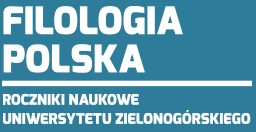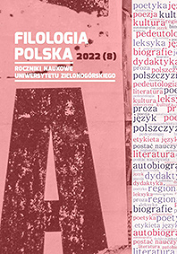The translation work of Saint Jerome and Hebraica Veritas
Keywords
Abstract
Saint Jerome is one of the most prominent figures of the Latin Church, in which he is considered to be the „prince of exegetes,” and Western culture, including the work of completing their spiritual synthesis based on the text of the Bible. Even today, his work has not lost much of its validity or inspiring meaning. Considering the present circumstances of the life of the Church, and especially the reading of the Bible, a closer look should be taken at Saint Jerome’s translation work and the method that he applied, which let him achieve lasting results. From a historical perspective, we try to draw attention to Jerome’s significant intellectual discovery, in which one can summarise the term Hebraica Veritas. It is about the priority given to Hebrew language – its cognition and understanding is a necessary condition for reaching the revealed truth and to the mystery of God itself. Based on his translation work, Jerome elaborated on scientific criteria for translating the Bible. Jerome’s perspective on a biblical canon also reflects the incorporation of the Jewish tradition.
References
Bell A.A., Jerome’s Role in the Translation of the Vulgate New Testament, „New Testament Studies” 1977 (23).
[Google Scholar]
Benedykt XV, Enc. Spiritus Paraclitus (15 września 1920), „Acta Apostolicae Sedis” 1920 (12).
[Google Scholar]
Benedykt XVI, Katecheza w czasie audiencji ogólnej. Św. Hieronim (I-II) (7 i 14 listopada 2007), „L’Osservatore Romano” 2008 (29), nr 1.
[Google Scholar]
Bartelink G.J.M., Hieronymus. Liber de optimo genere interpretandi (Epistula 57). Ein Kommentar, Leiden 1980 (Mnemosyne. Supplement, 61).
[Google Scholar]
Bober A., Wzorek J., Damazy I, [w:] Encyklopedia katolicka, t. 3, Lublin 1985, kol. 987.
[Google Scholar]
Bodin V., Saint Jérôme et l’Église, Paris 1966 (Théologie historique, 6).
[Google Scholar]
Brilli A., Gerusalemme, La Mecca, Roma. Storie di pellegrinaggi e di pellegrini, Bologna 2014.
[Google Scholar]
Brown D., Vir trilinguis. A Study in the Biblical Exegesis of saint Jerome, Kampen 1992.
[Google Scholar]
Carnevale L., Giobbe dall’antichità al medioevo. Testi, tradizioni, imagini, Bari 2010.
[Google Scholar]
Caruso G., Il monaco, l’erudito e ile vecchio: (auto)ritratti geronimiani, „Salesianum” 2021 (83).
[Google Scholar]
Cavallera F., Saint Jérôme. Sa vie et son oeuvre, t. 1-2, Louvain-Paris 1922.
[Google Scholar]
Chauffin Z., Święty Hieronim, przeł. B. Durbajło, Warszawa 1977.
[Google Scholar]
Cyceron, św. Hieronim, Burgundiusz z Pizy, Leonardo Bruni, O poprawnym przekładaniu. Teksty łacińskie i polskie, przeł. W. Seńko, J. Domański, W. Olszaniec, wstęp J. Domański, Kęty 2006 (Ad Fontes, 1).
[Google Scholar]
Dorival G., L’apport des Pères de l’Église à la question de la clôture du canon de l’Ancien Testament, [w:] The Biblical Canon, red. J.-M. Auvers, H.J. De Jonge, Leuven 2003.
[Google Scholar]
Franciszek, List apost. Scripturae Sacrae affectus (30 września 2020), „Vox Patrum” 2020 (76).
[Google Scholar]
Fürst A., Hieronymus. Askese und Wissenschaft in der Spätantike, Freiburg 2003.
[Google Scholar]
Gamberale L., San Gerolamo intellettuale e filologo, Roma 2013.
[Google Scholar]
García-Moreno A., La Bibbia della Chiesa. Storia e attualità della Neovolgata, Città del Vaticano 2012.
[Google Scholar]
Gasti F., Dispute epistolari fra dotti. Agostino e Girolamo, „Humanitas” 2019 (74).
[Google Scholar]
Gordini G.D., Origine e sviluppo del monachesimo a Roma, „Gregorianum” 1956 (37).
[Google Scholar]
Hale Williams M., The Monk and the Book. Jerome and the Making of Christian Scholarschip, London-Chicago 2006.
[Google Scholar]
Hennings R., Die Briefwechsel zwischen Augustinus und Hieronymus und ihr Streit um den Kanon des Alten Testaments und die Auslegung von Gal. 2, 11-14, Leiden-New York 1994.
[Google Scholar]
Hieronim ze Strydonu, Listy I (1-50), oprac. na podstawie tłumaczenia J. Czuja M. Ożóg, tekst łaciński przygotował H. Pietras, Kraków 2011 (Źródła Myśli Teologicznej, 54).
[Google Scholar]
Hieronim ze Strydonu, Listy II (51-79), oprac. na podstawie tłumaczenia J. Czuja M. Ożóg, tekst łaciński przygotował H. Pietras, Kraków 2011 (Źródła Myśli Teologicznej, 55).
[Google Scholar]
Hieronim ze Strydonu, Listy III (116-130), oprac. na podstawie tłumaczenia J. Czuja M. Ożóg, tekst łaciński przygotował H. Pietras, Kraków 2011 (Źródła Myśli Teologicznej, 62).
[Google Scholar]
Hieronim ze Strydonu, Listy IV (116-130), oprac. na podstawie tłumaczenia J. Czuja M. Ożóg, tekst łaciński przygotował H. Pietras, Kraków 2011 (Źródła Myśli Teologicznej, 63).
[Google Scholar]
Hieronim ze Strydonu, Listy V (131-156), oprac. na podstawie tłumaczenia J. Czuja M. Ożóg, tekst łaciński przygotował H. Pietras, Kraków 2013 (Źródła Myśli Teologicznej, 68).
[Google Scholar]
Jay P., La datation des premières traductions de l‘Ancien Testament sur l’hébreu par saint Jérôme, „Revue des Études Augustieniennes” 1982 (28).
[Google Scholar]
Jay P., Sur la date de la naissance de Saint Jérôme, „Revue des Études Latines” 1973 (51).
[Google Scholar]
Jeanjean B., Lançon B., Saint Jérôme, chronique. Continuation de la chronique d’Eusèbe, années 326-378. Suivie de quatre études sur les chroniques et chronographies dans l’antiquité tardive (IVe-VIe siècles). Histoire, Rennes 2004.
[Google Scholar]
Jérôme, Apologie contre Rufin, wyd. P. Loret, Paris 1983 (Sources Chrétiennes, 303).
[Google Scholar]
Jérôme, Préfaces aux livres de la Bible, wyd. R. Weber, R. Gryson, A. Canellis, Paris 2017 (Sources Chrétiennes, 592).
[Google Scholar]
Jérôme entre l’Occident et l’Orient. XVIe centenaire du départ de saint Jérôme de Rome et de son installation à Bethléem. Actes du colloque de Chantilly (septembre 1986), red. Y.-M. Duval, Paris 1988.
[Google Scholar]
Jouassard G., Réflexions sur la position de saint Augustin relativement aux Septante dans sa discussion avec saint Jérôme, „Revue des Études Augustiennes” 1956 (2).
[Google Scholar]
Jóźwiak M., Kwestie hebrajskie w Księdze Rodzaju św. Hieronima. Przekład i komentarz, Wrocław 2010.
[Google Scholar]
Jóźwiak M.M., Hieronim ze Strydonu jako „vir trilinguis” na przykładzie komentarza do Iz 7, 10-16, „Vox Patrum” 2020 (42), t. 76.
[Google Scholar]
Jóźwiak M.M., „Princeps exegetarum” a język hebrajski na podstawie „Quaestiones hebraicae in Genesim”, „Vox Patrum” 2016 (38), t. 65.
[Google Scholar]
Kelly J.N.D., Hieronim. Życie, pisma, spory, przeł. R. Wiśniewski, Warszawa 2003.
[Google Scholar]
Królikowski J., Jak powstała Wulgata i któremu tekstowi Pisma Świętego przysługuje to miano?, „Tarnowskie Studia Teologiczne” 2017 (36), nr 1.
[Google Scholar]
Królikowski J., Łacińskie tłumaczenia Pisma Świętego między V i XII wiekiem. Wybrane aspekty, „Przegląd Tomistyczny” 2019 (25).
[Google Scholar]
Królikowski J., Orygenes i hebrajski tekst Pisma Świętego, „Vox Patrum” 2018 (38), t. 69.
[Google Scholar]
Longosz S., Hieronim jako duchowy moderator klubu chrześcijańskich arystokratek na Awentynie, [w:] Przebóstwiać to, co ludzkie. Księga pamiątkowa ku czci Księdza Biskupa Władysława Bobowskiego, red. S. Sojka, J. Stala, Tarnów 2007.
[Google Scholar]
Markschies Ch., Hieronymus und die „Hebraica Veritas”. Ein Beitrag zur Archäologie des protestantischen Schriftverständnisses, [w:] Die Septuaginta zwischen Judentum und Christentum, red. M. Hengel, A.M. Schwemer, Tübingen 1994.
[Google Scholar]
Mazurkiewicz R., Syrycjusz, [w:] Encyklopedia katolicka, t. 18, Lublin 2013.
[Google Scholar]
Mirri L., La dolcezza nella lotta. Donne e ascesi secondo Girolamo, Magnano 1996.
[Google Scholar]
Misiarczyk L., Gdzie leżał starożytny Strydon? Przegląd najważniejszych hipotez, „Vox Patrum” 2020 (76).
[Google Scholar]
Rebenich S., Hieronymus und sein Kreis. Prosopographische und socialgeschichtliche Untersuchungen, Stuttgart 1992.
[Google Scholar]
Schlange-Schöningen H., Hieronymus. Eine historische Biografie, Darmstadt 2018.
[Google Scholar]
Sołomieniuk M., Świętego Hieronima przedmowy do ksiąg biblijnych w Wulgacie – zagadnienia wstępne, „Vox Patrum” 2020 (76).
[Google Scholar]
Stemberger G., Juden und Christen im Heiligen Land, München 1987.
[Google Scholar]
Święty Hieronim: egzegeta, dogmatyk, polemista, red. P. Wygralak, Poznań 2019 (Teologia Patrystyczna, 16).
[Google Scholar]
Verbraken P.-P., Starowieyski M., Ojcowie Kościoła. Panorama patrystyczna, przeł. M. Starowieyski, S. Kawecki, Warszawa 1991.
[Google Scholar]
Preview
Downloads
Published
How to Cite
Issue
Section
Categories
Copyright & License

This work is licensed under a Creative Commons Attribution-NonCommercial-NoDerivatives 4.0 International License.
Copyrights (a). In principle, authors who are not employed by the University of Zielona Góra retain the copyright, including publishing rights to the articles, without restrictions.
Copyrights (b). In principle, authors who are employed by the University of Zielona Góra, do not retain the copyright, including publishing rights to the articles. In such cases the copyright holder is the University of Zielona Góra.
Print ISSN
2450-3584-
Abstract151











































